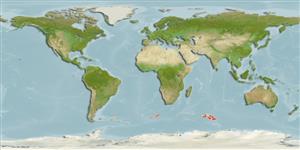Environment: milieu / climate zone / depth range / distribution range
Ökologie
seewasser bathydemersal; tiefenbereich 620 - 1600 m (Ref. 51661). Deep-water; 47°S - 59°S
Southern Ocean. Three subspecies are recognized by Andriashev (2003): Paraliparis thalassobathyalis thalassobathyalis from Banzare and Elan banks at Kerguelen Plateau, Heard Island, and Crozet Islands at 620 - 1,600 meters; Paraliparis thalassobathyalis meteorensis, common at Meteor Seamount at 800 - 1100 meters; and an unnamed one found west of South Georgia Island, Shag Rocks at 620-635 meters.
Size / Gewicht / Alter
Maturity: Lm ? range ? - ? cm
Max length : 13.5 cm SL Männchen/unbestimmt; (Ref. 5196)
Kurzbeschreibung
Morphologie | Morphometrie
Rückenflossenweichstrahlen (insgesamt): 49-53; Afterflossenweichstrahlen: 44 - 46; Wirbelzahl: 56 - 59. This species is characterized by the following: simple teeth with lateral cusps; gill rakers 4-6; not approximated chin pores; small opercular opening, equal or larger than diameter of pupil; small opercular lobe; pectoral fin with distinct notch; head 20-23%, anteanal distance 38-42% SL. Colour of peritoneum and stomach black (Ref. 44814).
Eggs measures 2.5-3 mm diameter (Ref. 11892).
Life cycle and mating behavior
Geschlechtsreife | Fortpflanzung | Ablaichen | Eier | Fecundity | Larven
Stein, D.L. and A.P. Andriashev, 1990. Liparididae. p. 231-255. In O. Gon and P.C. Heemstra (eds.) Fishes of the Southern Ocean. J.L.B. Smith Institute of Ichthyology, Grahamstown, South Africa. (Ref. 5196)
IUCN Rote Liste Status (Ref. 130435)
Bedrohung für Menschen
Harmless
Nutzung durch Menschen
Fischereien: nicht kommerziell
Mehr Information
NamenSynonymeMetabolismusRäuberÖkotoxikologieFortpflanzungGeschlechtsreifeAblaichenSpawning aggregationFecundityEierEientwicklung
Alter/GrößeWachstumLänge-GewichtLänge-LängeLängenhäufigkeitenMorphometrieMorphologieLarvenLarven Pop.Dyn.RekrutierungDichteBRUVS
ReferenzenAquakulturAquakultur ProfilZuchtlinienGenetikElectrophoresesVererbbarkeitKrankheitenVerarbeitungNutrientsMass conversion
PartnerBilderStamps, Coins Misc.LauteCiguateraGeschwindigkeitSchwimmstilKiemenoberflächeOtolithsGehirngrößeSehfähigkeit
Tools
Zusatzinformationen
Download XML
Internet Quellen
Estimates based on models
Preferred temperature (Ref.
123201): 1.9 - 2.3, mean 2.1 °C (based on 15 cells).
Phylogenetic diversity index (Ref.
82804): PD
50 = 0.5000 [Uniqueness, from 0.5 = low to 2.0 = high].
Bayesian length-weight: a=0.00525 (0.00237 - 0.01161), b=3.15 (2.96 - 3.34), in cm total length, based on LWR estimates for this (Sub)family-body shape (Ref.
93245).
Trophic level (Ref.
69278): 3.5 ±0.5 se; based on size and trophs of closest relatives
Widerstandsfähigkeit (Ref.
120179): mittel, Verdopplung der Population dauert 1,4 - 4,4 Jahre. (Assuming tmax>3).
Fishing Vulnerability (Ref.
59153): Low vulnerability (10 of 100).
